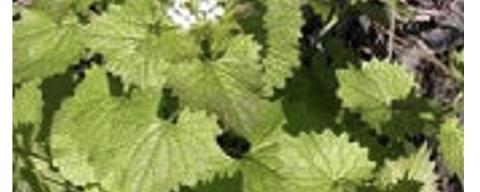Wanted: Garlic Mustard
Please help us fight this plant! If you have garlic mustard in your yard or community, please pull the stalks (including the roots) before the white flowers go to seed and spread.
Garlic mustard is a pernicious non-native plant which:
- Releases sinigrin, preventing the growth of other plants by disrupting a beneficial fungus that plants rely on to get nutrients
- Crowds out native plant species, reducing the natural biological diversity in our woods
- Reduces food for birds, insects and other critters that depend on early native plants for their foliage, pollen, nectar, fruits, seeds and roots of their essential food sources when garlic mustard replaces them
Join us in the garlic mustard challenge, a regional effort to restore natural ecosystems. Volunteer on your own, or join a group pull at https://naturegroupie.org/resources/garlic-mustard-challenge-new-england
Removing Garlic Mustard
Garlic mustard fortunately does NOT regenerate from root fragments. Therefore, this is one of the few invasive plant species that can be controlled manually by pulling.
PULL before it flowers, removing crown and roots. Pulling seedlings and small or shallow-rooted plants is easiest when soil is moist (April & May are best). Dig out larger plants, including the root systems. Tamp down soil afterwards.
Disposal of Pulled Plants
- Do not compost or put in backyard waste! (Evidence shows it can set seed from flowers even when cut, if it touches soil.)
- If garlic mustard is pulled before ANY seed formation, pile plants on site and cover with plastic to allow decomposition.
- If any chance of seed production, bag plants and dispose of at landfill or in a burn pile. Most NH land managers put the pulled plants in plastic bags (less chance of seed migration), in the sun for 1-2 months to disintegrate.
Large populations can be continuously cut back to prevent flowering and seed production, according to NH Department of Agriculture, Markets & Food, Division of Plant Industry. Just be sure to do it well before the plant sets seed!
Eat it to Beat It
Add a few young leaves to your salad. Or make garlic pesto (recipe here).
Garlic Mustard Resources
- UNH Extension Garlic Mustard Challenge Fact Sheet
- NH Department of Agriculture, Markets & Food Garlic Mustard Fact Sheet
- NH Guide to Upland Invasive Species. See page 8 for garlic mustard.

Photos from the NH Department of Agriculture, Markets and Food’s fact sheet on garlic mustard: https://www.agriculture.nh.gov/publications-forms/documents/garlic-mustard.pdf

